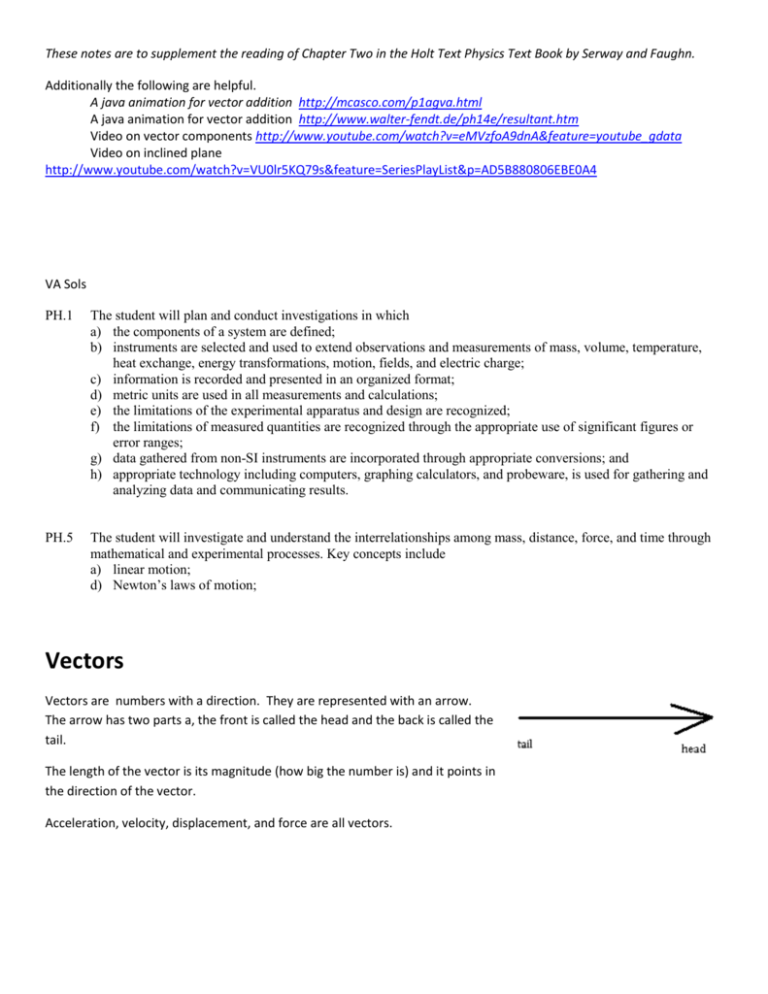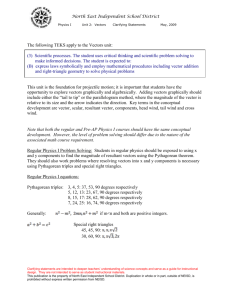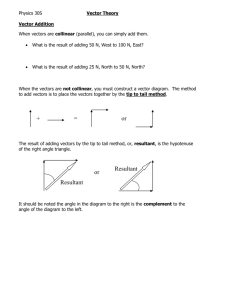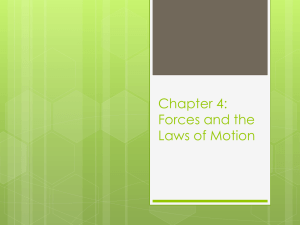Vector notes
advertisement

These notes are to supplement the reading of Chapter Two in the Holt Text Physics Text Book by Serway and Faughn. Additionally the following are helpful. A java animation for vector addition http://mcasco.com/p1agva.html A java animation for vector addition http://www.walter-fendt.de/ph14e/resultant.htm Video on vector components http://www.youtube.com/watch?v=eMVzfoA9dnA&feature=youtube_gdata Video on inclined plane http://www.youtube.com/watch?v=VU0lr5KQ79s&feature=SeriesPlayList&p=AD5B880806EBE0A4 VA Sols PH.1 The student will plan and conduct investigations in which a) the components of a system are defined; b) instruments are selected and used to extend observations and measurements of mass, volume, temperature, heat exchange, energy transformations, motion, fields, and electric charge; c) information is recorded and presented in an organized format; d) metric units are used in all measurements and calculations; e) the limitations of the experimental apparatus and design are recognized; f) the limitations of measured quantities are recognized through the appropriate use of significant figures or error ranges; g) data gathered from non-SI instruments are incorporated through appropriate conversions; and h) appropriate technology including computers, graphing calculators, and probeware, is used for gathering and analyzing data and communicating results. PH.5 The student will investigate and understand the interrelationships among mass, distance, force, and time through mathematical and experimental processes. Key concepts include a) linear motion; d) Newton’s laws of motion; Vectors Vectors are numbers with a direction. They are represented with an arrow. The arrow has two parts a, the front is called the head and the back is called the tail. The length of the vector is its magnitude (how big the number is) and it points in the direction of the vector. Acceleration, velocity, displacement, and force are all vectors. 3 ways to name a vector The first way it to use degree notation. Since this is 35 deg less than the 90 deg. We can name this vector 40N @ 55⁰. The next two way involve treating the axis like a compass rose. We can name the vector by how far away it is from an axis. So this becomes 40N @35⁰ E of N Because the vector is at the location, where if you start at North and go 35 deg to the East of it. Furthermore We can also find the angle from East. There are 90 degrees between East and North. Since the vector is 35 degrees to the East of North we can subtract from 90 degrees and we get 55 degrees. So we can name the vector 40N at 55⁰ N of E. Another Example: 50 m/s @ 25⁰ 50 m/s @ 25⁰ N of E 50 m/s @ 65⁰ E of N 45 m/s @ 240⁰ 45 m/s @ 30⁰ W of S 45 m/s @ 60⁰ S of W Diagrams on this page are not to scale. Vectors are always added head to tail. The sum or two or more vectors is the resultant. Ways to add vectors 1. 2. 3. 4. 5. Graphical Method Pythagorean theorem Components Matrix – not explained in these notes Law of Sines and Cosines - not explained in these notes Using the Graphical Method With the graphical method you use a ruler and protractor. Start with your principle axis and making a scale, and then graph the vectors head to tail. For example: Find the resultant velocity of a bird flying 9.0m/s @ 30⁰N of E in a wind that is blowing 2m/s @ 20⁰N of W. First, we draw our principle axis. Then we make a scale. For our purpose we will use 2m/s =1cm I will then use a protractor to find 30deg North of East and put a mark there. (Highlighted for emphasis) Now I will use my scale to determine how far to draw the line. 9.0m/s ( 1𝑐𝑚 2𝑚/𝑠 )= 4.5 cm Next, we use a ruler to draw a 4.5cm line toward the 30 degree mark. Now, at the head of the first vector, we make a secondary axis and use the protractor and mark 20 degrees N of W. (Highlighted here.) 1𝑐𝑚 The next vector is drawn in that direction, 2m/s (2𝑚/𝑠)= 1cm long Then the resultant, shown in green here, is measured and the angle found. (I got 3.9 cm @ 42⁰ N of E) Using our scale this becomes 3.9 cm( 2𝑚/𝑠 1𝑐𝑚 )=7.8m/s @ 42⁰ Using the Pythagorean Theorem Vectors that are at right angles from each other can be added using the Pythagorean Theorem. Since you are using math to determine the length of the vectors, all of the rest of the images will not be to scale. For example: A persons walks so they have a displacement 30m due N then they turn and walk again so they have a displacement of 20 m due East, what is their total displacement for both time periods. Start by free handing the vectors on the principle axis head to tail. Next I sketch in the resultant (in green) and use the Pythagorean Theorem to calculate the length. A2 +B2 = C2 (30m)2 + (20m)2 =C2 C=√900 + 400 C=36m Now we need to find the angle Ѳ. To do this we use SOHCAH-TOA TOA means Tan Ѳ = opp/adj side on a triangle. For this situation we get Tan Ѳ = 20 𝑚 30 𝑚 20 𝑚 ) 30 𝑚 Ѳ = Tan – ( (Note: Your calculator must be in deg mode.) Ѳ = 33.7 degrees So our answer is 36m @ 33.7⁰ E of N or 36m at 54.3⁰ N of E Using vector Components Components are used when you have most of your vectors will add like a 1-D problem. You can break a vector into pieces (components) that go along the axis and simple add and subtract them. Example: A twenty kg box is pulled with 100 N@ a 30 degree angle from the horizontal across a floor, which has a coefficient of friction of .45 with the box. What will the acceleration be? First, make a sketch with a free body diagram. Now, we can start putting the numbers into our diagram. Force of weight is just mg. The force applied was given, however, we need to find the component of this vector that are along the x and y axis. We will use SOH-AH-TOA for this. Once the Fax and Fay are calculated, we will work on the Fn and Ff. Remember that Fn is the force pushing perpendicularly out of the surface. Therefore we will calculate it by subtracting Fay from the absolute value of the force of weight. Now we are ready to solve for the acceleration using Newton’s 2nd Law. Bear in mind, Fn + Fay + Fw cancel each other out. All of the movement will be horizontal, no movement will be vertical. ∑F=ma Ff + Fax = ma -65.7 N + 86.6 N = 20kg (a) a = 1.05 m/s2 It is interesting to note here. That because the Fa is pulling up as well as forward that force normal is reduced. This is important, because if force normal is reduced so is friction. What this means is for items with a lot of friction, it is easier to pull at an angle than straight across. Using vector Components On an Incline When you encounter inclined plane problems it is often easiest to solve the problem, by turning your axis along the inclined plane, and using vector components to deal with the force of weight. Normal Axis Tilted Axis An Example. A .5kg box is on a inclined plane that has been tilted at 15 degrees above the horizontal. If the coefficient of friction is .1, what will the acceleration be? We start with a sketch and a free body diagram. Next we break the Fw into its components that are parallel (||) and perpendicular (┴) to the inclined plane. Then we put the numbers into the diagram. First calculate the force of weight. Next use SOH-CAH-TOA to calculate F|| and F ┴. Bear in mind that F┴ is negative and F|| is positive. Force normal is the opposite of F┴ here. Force friction is also in the negative dir. Finally we can calculate the acceleration by using Newton’s 2nd law. Bear in mind Fw is not used and its components F|| and F┴ are used in its place. F┴ and Fn cancel each other out. ∑F=ma Ff +F|| =ma -0.473 N + 1.27 N = (.5kg)(a) a=1.59m/s2




